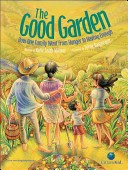
The Good Garden
Written by Katie Smith Milway
Illustrated by Sylvie Daigneault
Kids Can Press, 2010, 31 pp.
ISBN: 978-15545534883
The latest in a collection by Kids Can Press that is designed to inform and inspire children as global citizens, The Good Garden takes readers to the hills of Honduras where farmers, such as the family of María Luz Duarte, struggle to grow enough food to feed themselves. With poor rainfall, insect invasions, and land in need of nutrients, María worries that they will have to borrow seeds from the coyote, who, in turn, will charge them many times more in repayment. Ultimately, the farmers, campesinos, can lose their land to the coyotes. Hoping to avoid this, María’s father leaves to take physically difficult temporary work on a coffee farm.
Readers become part of the daily activities of the Duarte family, learning much about the culture of the Honduran farming community. María goes to school where a new teacher has big ideas to help the children make their lives better. Through helping Don Pedro with the class garden, María learns many things about restoring the land—creating compost, building terraces along the hillside to keep land from washing away, planting marigolds to keep insects away, and planting beans with other crops to put nutrients back into the soil. When her father returns with money for seeds, María and her father plant their garden using their new knowledge. Ultimately, they not only feed themselves but have crops to sell. Other families make improvements as well and are able to by-pass the greedy coyotes as they improve their land and lives. As is the custom in Honduras, Don Pedro is eventually assigned another school, but his contributions to this community remain. Sylvie Daigneault uses colored pencil and colored paper in the illustrations to share the story in brightly detailed images. The pictures provide insight to the story while maintaining a hopeful tone due to the bright yellow colors.
Katie Smith Milway offers much insight into this story and into the “global garden” in the final pages of this book. Readers learn that the Duarte family is based on a real family and the teacher, Don Pedro, is based on a Honduran who worked throughout his life to educate farmers about their land and about cash crops, thus enabling them to provide money for medicines and school supplies. With 75 percent of the poor being farmers in developing countries, such information is critical to making more individuals “food secure”—having enough food to eat. Milway opens the discussion to include the global community. Using Don Elías as a model to inspire, she challenges readers to consider what they can do by providing suggestions, organizational contacts for involvement, and explanations of the work of organizations such as MicroEnsure and the Heifer International project. A vocabulary list is provided as she uses authentic vocabulary for key words.
In her acknowledgement, Milway recognizes Milton Flores and Margoth Andrews, individuals continuing the work of Elías, for reviewing the language and illustrations for authenticity. She also consulted others regarding the global messages included in this book. Milway is involved in programs for sustainable development on a global scope and currently is involved in a nonprofit organization, One Hen, Inc., that uses many resources to teach children financial responsibility and giving back.
The Good Garden offers many possibilities to inform readers about countries that struggle economically and often do not have much literature available that reflect their people and lifestyles. Of course, the larger theme is the role of education and support to create empowered members of the global community. Helping young citizens realize they can participate in such global transformations is a purpose of this and other books in the CitizenKid series by Kids Can Press. This book can naturally be used with its companion titles such as One Hen: How One Small Loan Made a Big Difference, (Katie Smith Milway, 2008), One Well: The Story of Water on Earth (Rochelle Strauss, 2007), or If the World Were a Village: A Book about the World’s People (David J. Smith, 2002). Other titles on this topic might include What the World Eats (Faith D’Aluisio, 2008) or Planting the Trees of Kenya: The Story of Wangari Maathai (Claire Nivola, 2008). The book can also play a key role in a science text set that focuses on the process of growing food or farming.
Janelle B. Mathis, University of North Texas, Denton, TX
WOW Review, Volume III, Issue 1 by Worlds of Words is licensed under a Creative Commons Attribution-NonCommercial-ShareAlike 4.0 International License. Based on work at https://wowlit.org/on-line-publications/review/iii-1/

This book sounds like I would enjoy it. When I first started reading about it, I thought it was going to remind me of KIRA-KIRA. That book also mixes her native language into the text, but it flows enough that you can too usually figure out what it means through context. For this book, I would like the “aha” chapter titles and the complexity of the circle element. It’s also a good book to add to any collection as it’s always nice to be culturally diverse with your collection.